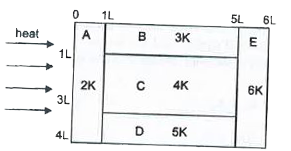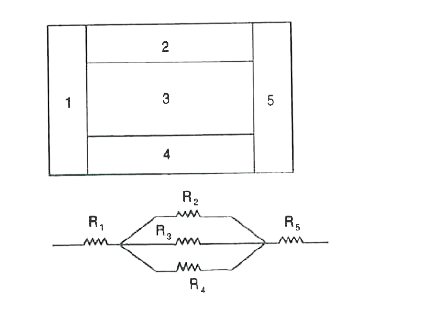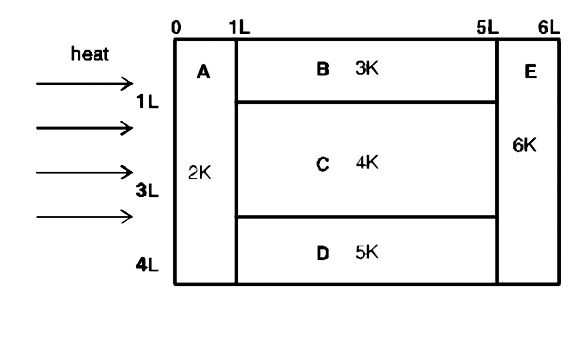A composite block is made of slabs A,B,C,D and E of different thermal conductivities (given in terms of a constant K) and sizes (given in terms of length, L) as shown in the figure. All slabs are of same width. Heat 'Q' flows only from left to right through the blocks.
Then in steady state
 Solution in Kannada
Solution in Kannada
heat flow through A and E slabs are same.
heat flow through slab E is maximum
temperature difference across slab E is smallest.
heat flow through C = heat flow through B + heat flow through D.
The correct Answer is:A, C, D

Let width of each rod is d
R1=18kd,R2=43kd
R3=12kd,R4=45kd
R5=124kd,
Correct choice is (a,c,d)
Topper's Solved these Questions
- BOOK - MODERN PUBLICATIONCHAPTER - TRANSFERENCE OF HEAT EXERCISE - Recent Competitive Questions4videos
TRANSFERENCE OF HEAT
- BOOK - MODERN PUBLICATIONCHAPTER - TRANSFERENCE OF HEAT EXERCISE - Multiple Choice Questions (Level - II)49videos
TRANSFERENCE OF HEAT
- BOOK - MODERN PUBLICATIONCHAPTER - SOLIDS & SEMICONDUCTOR DEVICESEXERCISE - Revision Test28videos
SOLIDS & SEMICONDUCTOR DEVICES
- BOOK - MODERN PUBLICATIONCHAPTER - UNIFORM CIRCULAR MOTIONEXERCISE - Revision Test57videos
UNIFORM CIRCULAR MOTION
Similar Questions
Two slabs are of the thicknesses d1 and d2. Their thermal conductivities are K1 and K2 respectively They are in series. The free ends of the combination of these two slabs are kept at temperatures θ1 and θ2. Assume θ1>θ2. The temperature θ of their common junction is
07:42View SolutionTwo vessels of different materials are similar in size and other respects. The same quantity of ice filled in them gets melted in 40 and 70 minutes respectively. The ration of thermal conductivities for the materials of boxes is :
03:34View SolutionChoose the forward biased p-n junction :
01:47View SolutionA sphere of mass m is tied to end of a string of length 1 and rotated through the other and along a horizontal circular path with speed . The work done in full horizontal circle is:
05:32View SolutionA composite block is made of slabs A,B,C,D and E of different thermal conductivities (given in terms of a constant K and sizes (given in terms of length, L) as shown in the figure. All slabs are of same width. Heat 'Q' flows only from left to right through the blocks. Then in steady state
 04:03View Solution
04:03View SolutionThe temperature across two different slabs A and B are shown I the steady state (as shown Fig) The ratio of thermal conductivities of A and B is
09:24View SolutionThe diagram shows four slabs of different materials with equal thickness, placed side by side. Heat flows from left to right and the steady-state temperatures of the interfaces are given. Rank the materials according to their thermal conductivities, smallest to largest.
View SolutionTwo slabs A and B of different materials but of the same thickness are joined end to end to form a composite slab. The thermal conductivities of A and B are K1 and K2 respectively. A steady temperature difference of 12∘C is maintained across the composite slab. If K1=K22, the temperature difference across slab A is
15:35View SolutionTwo slabs A and B of different materials but of the same thickness are joined end to end to form a composite slab . The thermal conductivities of A and B are K1 and K2 respectively . A steady temperature difference of 12∘C is maintained across the composite slab . If K1=K22 , the temperature difference across slab A is
01:32View SolutionA composite slab consists of two slabs A and B of different materials but of the same thickness placed one on top of the other. The thermal conductivities of A and B are k_(1) and K_(2) respectively. A steady temperature difference of 12^(@)C is maintained across the composite slab. If k_(1) = K_(2)//2 , the temperature difference across slab A will be:
02:12View SolutionA parallel-sided slab is made of two different materials. The upper half of the slab is made of material X, of thermal conductivity λ, the lower half is made of material Y, of thermal conductivity 2λ. In the steady state, the left hand face of the composite slab is at a higher, uniform temperature than the right-hand face, and the flow of heat through the slab is parallel to its shortest sides. What fraction of the total heat flow through the slab passes through material X ?
02:22View Solutionअलग-अलग ताप चालकताओं (K के मात्रक में ) तथा अलग अलग साइजों (L के मात्रक में) के A,B,C,D व E स्लैबो को चित्र में दर्शाये अनुसार जोड़ा गया है। सब स्लैबों की चौड़ाई समान है । ऊष्मा Q का चालन सिफ A से E की दिशा में है तब साम्यावस्था में
 02:18View Solution
02:18View SolutionTwo slabs A and B of different materials but of the same thicknesss are joined end to end to form a composite slab. The thermal conductivities of A and B are K1 and K2 respectively. A steady temperature difference of 12∘C is maintained across the composite slab. If K1=K22, the temperature difference across slabs A is
10:21View SolutionA composite slab is made of two parallel layers of two different materials of thermal conductivities K_1 and K_2 are of same thickness. Show that the equivalent thermal conductivity of the slab is (2K_1 K_2)/( K_1 + K_2)
10:10View Solutionएक संयुक्त स्लैब पर विचार कीजिए, जिसमें समान लंबाई, मोटाई, अनुप्रस्थ काट और तापीय चालकताएँ क्रमश: K और 2K वाले दो अलग-अलग पदार्थ श्रेणीक्रम में जुड़े हुए हैं। स्लैब की तुल्य तापीय चालकता है:
03:06View Solution

